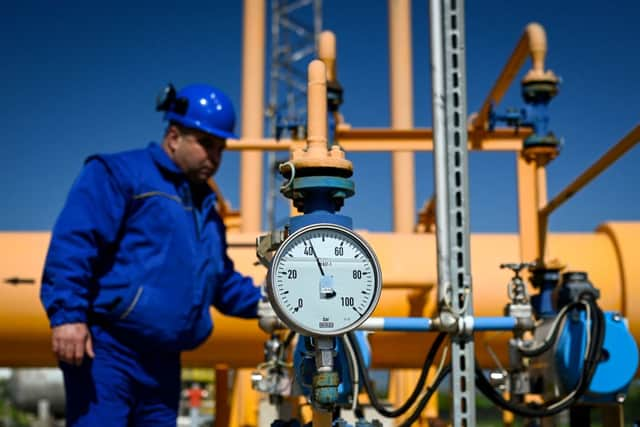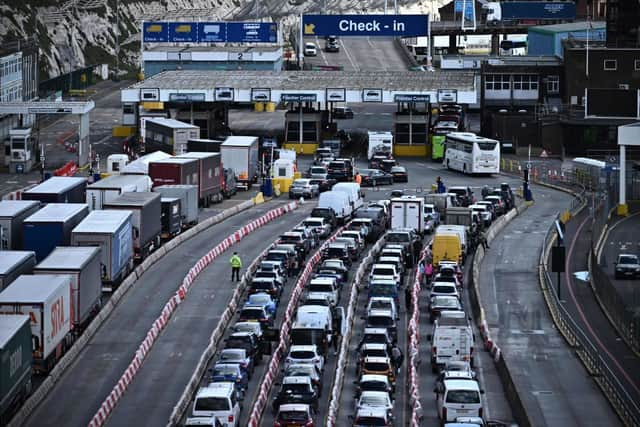Why is UK inflation rate so high? How UK CPI compares to other major economies, including US and Germany
and live on Freeview channel 276
UK inflation once again failed to decline as economists hoped, falling from 10.1% in March to 8.7% in April - short of the 8.2% that had been widely expected.
It means the cost of living crisis is dissipating at a slower pace than forecast. Falling inflation means prices are still rising - but not as fast - with April’s figure still considered to be a rapid rate of inflation.
The Consumer Prices Index’s (CPI’s) fall was mostly thanks to energy prices, which did not increase to the same extent as they did in April 2022 when the Ofgem energy price cap soared 54%. But what is troubling economists and the government is that food prices remained close to a 45-year peak at 19.3%, while core inflation actually rose rather than fell.
It means the Bank of England could bring in another interest rates hike in June. It raised its bank rate to 4.5% earlier in May in a bid to squeeze inflation down towards its target of 2%.
So, why is UK inflation so high - and how does its rate compare to other countries? NationalWorld has looked at the CPIs of other economies to find out.
What is the CPI?
The Consumer Prices Index (CPI) is the world’s main way of measuring inflation. It allows for direct international comparisons, which means we can see how the UK compares to other countries.
It is not a perfect measure of the cost of living given it does not include mortgages or other household costs, like council tax. But it does give us a strong indication of how much more expensive goods and services are getting, as well as how much our purchasing power is diminishing.


The CPI is based on a ‘basket of goods’ - a list of items deemed to be central to UK daily life. This basket is measured monthly and updated annually by the Office for National Statistics (ONS) to reflect changing shopping habits.
For example, meat-free sausages, sports bras and antibacterial surface wipes were added in 2022, and E-bikes, home security cameras and frozen berries have just been added for this year. Casualties from the 2023 basket of goods include alcopops, digital compact cameras and CDs that are not in the UK Top 40.
This basket is weighted so that goods which are necessities for all households, like fruit and vegetables, have a bigger influence over the index than items that are less vital. These weightings also change over time as shopping habits change or new products move into the mainstream.
As of March 2023, the index stood at 10.1%. In practice, this means that something which cost £1 in March 2022 now costs £1.10. But it also comes after an annual rise of 7% in March 2022, so the current rate should be seen as being in addition to that large increase.
How does UK inflation compare to other countries?
The International Monetary Fund (IMF) describes the UK as being an ‘advanced’ economy. So, NationalWorld has taken the G7 economies and a select group of other similar ‘advanced’ economies that neighbour us in Western and Northern Europe to see how its inflation rate compares.
Loading....
As our graphic shows, the UK’s inflation rate is higher than in the 10 other economies we’ve compared it to. Even countries like the Netherlands, which had an inflation rate of 17.2% in September 2022, are now in a much better position with their rate of price rises.
Several countries have seen their CPI creep upwards, most notably the Netherlands (up from 4.4% in March) and Italy (up from 7.6%), with both countries seeing an upward shift in energy and fuel prices. Given the UK has come down from its March figure of 10.1%, it is now not as much of an outlier as it was.
There are three main caveats to note when comparing the UK internationally. Firstly, the USA and Canada have access to vast quantities of natural resources and commodities within their borders, which means they have been less exposed to the price shocks caused by the war in Ukraine. Secondly, the fact that the EU countries in the list above share a currency and a central bank means comparisons are not necessarily like-for-like.


Thirdly, core inflation in comparable economies is actually not that dissimilar to the UK’s rate. Core CPI ignores volatile or seasonal categories, like food and energy, that we consume regardless of price.
Instead, it shows us price changes for goods and services we consume regularly but can opt to cut back on if prices go up too much, like going to the cinema or eating out. The ONS says the metric is used to “assess the underlying inflationary pressures in the economy” whereas headline CPI can “be driven by temporary supply shocks, or other effects that do not have a lasting impact”.
The rate was 6.8% in the UK in April 2023 - a 0.6 percentage point rise month-on-month that means it is now at its highest rate since March 1992. It was partly driven by increases in recreation and culture (e.g. book prices jumped from 4.6% to 18%) and communication services (e.g. stamps saw significant price hikes in April). The latest core inflation hike means the Bank of England will be pencilling in another interest rate rise in June.


The UK figure is still the highest out of the countries we have looked at (and comes in as the fifth highest among G20 nations). But with Spain (6.6%), the Netherlands (6.6%), Ireland (6.4%), Italy (6.3%) and France (6.3%). The nations with the lowest core CPIs were Japan (3.4%) and Canada (4.1%). What the figures suggest is that inflation is proving to be stickier in the UK and Europe than in other parts of the world.
Why is the UK’s inflation rate so high?
The reason why the UK’s headline rate of CPI inflation is so much higher than those of other comparable economies is mostly down to the UK’s exposure to the continued shocks emanating from Russia’s invasion of Ukraine, but also has its origins in Brexit and the labour market.
Russia-Ukraine
The UK has been particularly exposed to the war because, as IMF director of research Pierre-Olivier Gourinchas said in April, it has a “higher dependence on imported energy” than “comparable economies”. The country also imports around 60% of its food.
Both energy and food have been subjected to massive price shocks as Russia and Ukraine are key sources of vital commodities. Russia is the world’s second largest natural gas producer, while Ukraine is one of the globe’s biggest wheat exporters.


Energy prices were up 85.6% on the UK CPI in March but have fallen to 24.3% in April thanks to how inflation is calculated (the most recent data removes the shock of the energy price cap increase in April 2022 when the Ofgem cap soared 54%). According to independent analyst Capital Economics, the UK’s energy price guarantee and support payments have not been as generous as other schemes in EU countries. Meanwhile, the lag between falling wholesale prices and their reflection in the Ofgem price cap means energy prices have been falling back at a slower rate than those on the continent.
Food prices - which have a greater bearing on the headline CPI rate - were 19.3% higher in the UK on the CPI. Part of the reason is that the high energy prices seen in the UK have made production more expensive, and increased the cost of key inputs, like fertiliser and feed. As well as the war in Ukraine, recent shortages of fruit and vegetables have also played a part in driving prices higher, particularly given that the country imports more food than it grows.
Brexit
While it is hard to measure exactly what impact Brexit has had on inflation, economists believe it has played a role in why the UK’s inflation rate is so far above those of other economies.


William Marsters, senior sales trader at Saxo UK, says: “one piece of the sticky inflation puzzle stems from the UK’s exit from the EU. This has strained the labour market, inflating wages. Brexit also made the UK more vulnerable to food imports which have played their part in the price increases.”
But recent developments may have helped to ease inflation slightly. In May, the IMF praised Rishi Sunak’s Windsor Framework post-Brexit deal for Northern Ireland - a move that looks set to free up trade between the country and the rest of Great Britain.
Labour market
Other non-Brexit-related labour market issues that economists say are driving inflation higher are long-term sickness, early retirement and pay rises. The last of these has become a particularly contentious issue that has led to strike action on a vast scale.
Analysis by Capital Economics has found wage rises have been steeper in the UK than in the EU, going up by 6.6% annually on average compared to 5.1% in the eurozone - something which is generating more demand (and therefore, price rises) in the economy. Explaining the problem, Danni Hewson - head of financial analysis at investment platform AJ Bell said: “Wages have risen, even if most people haven’t felt the benefit because of those price hikes, and businesses will have to find a way to recoup those increases if they haven’t already passed the costs onto their customers.”
However, not everyone believes worker wages are to blame. Progressive think tank IPPR said the focus should actually be on what it called “greedflation” where “companies continue to make higher profits from price hikes, ignoring the impact on consumers.”
Comment Guidelines
National World encourages reader discussion on our stories. User feedback, insights and back-and-forth exchanges add a rich layer of context to reporting. Please review our Community Guidelines before commenting.
